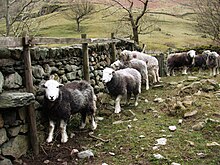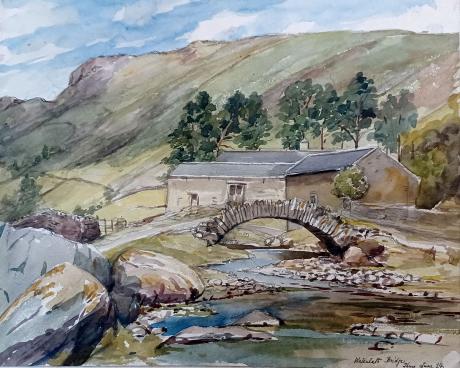inscribed and dated "Watendlath Bridge Cumbria Thurs June 24 1873" and signed with initials "LWT"
Tom and Laura Taylor and thence by descent
The little hamlet of Watendlath, owned by the National Trust, sits high between the Borrowdale and Thirlmere valleys. It is 847 feet above sea level, with an attractive tarn surrounded by fells in a classic ‘hanging valley’. Watendlath beck is the source for Lodore Falls – a tourist attraction from Victorian times.
Watendlath has an attractive packhorse bridge, and a National Trust tea-room, particularly pleasant in good weather when you can sit outside at tables and watch the birds. The hamlet is reached by a very narrow road with passing places, from the Keswick to Borrowdale road. This is a steep climb at first before crossing the famous Ashness Bridge (below), then past ‘Surprise View’ where it is possible to park and look out over the whole of the Derwentwater valley (see photo in ‘gallery’). Take care with children as there are no barriers and this is the top of a cliff.
Watendlath was used by Sir Hugh Walpole as a setting for the fictional home of Judith Paris in his haunting Herries saga, a series of four novels published in the early 1930’s.
One of the most scenic and often photographed Lake District locations, Watendlath is a hamlet high up in a hanging valley above Derwentwater, between the Borrowdale and Thirlmere valleys. An old packhorse bridge spans the beck, and there are walking trails over Grange Fell.
The peculiar name comes from a combination of Old Norse words meaning 'water-end barn'. The reference is still valid today, for the only access is a dead-end road that terminates at Watendlath Farm.
There is not much to Watendlath itself beyond the farm, and Watendlath Tarn. The tarn is fed by water from Blea Tarn Gill, and the outflow feeds Lodore Falls, near the lake below. The tarn was given to the National Trust by Princess Louise, Queen Victoria's daughter, in memory of her brother, Edward VII. The tarn is stocked with trout and is a popular spot for fly fishing.
Like much of the Lake District, Watendlath is owned by the National Trust, who lease out the farm. The Trust also owns the Herdwick sheep managed by the farm tenant, thus helping ensure the survival of this rare breed. The farm was the subject of a 1921 painting by Dora Carrington that now hangs in the National Gallery in London.
The National Trust owns a bothy beside the tarn that they rent out as very basic holiday accommodation.Watendlath is the fictional home of Hugh Walpole's heroine 'Judith Paris' in his series of 4 'Herries Saga' novels.
There is only one way to reach Watendlath by car, and that is by a lane off the B5289 from Keswick to Borrowdale. It is easy to miss the lane, but if you are coming south from Keswick and you reach the Lodore Hotel, you've come too far! The lane is very narrow, with passing places, so drive carefully.
The road crosses Ashness Bridge, a picturesque stone-built bridge across the beck, with views across Derwentwater to the peak of Skiddaw. Beyond the Ashness Bridge is Surprise View, where there is a parking place beside a cliff-top viewpoint looking out over the Derwentwater valley.
Watendlath Tarn is fed by Bleatarn Gill from Blea Tarn, 700 feet (210 m) above, below Bell Crags. Water from Watendlath Tarn flows into the beck of the same name and eventually feeds Lodore Falls, and ends up in Derwent Water.
The tarn is 7 acres (28,000 m2) in size, with a maximum depth of 56 feet (17 m). It was given to the National Trust by Queen Victoria's daughter, Princess Louise, in memory of her brother, King Edward VII.
Watendlath Tarn is stocked with brown trout and rainbow trout and is a popular fly fishing water, with wading and boat fishing used.
Watendlath is within the Copeland UK Parliamentary constituency. Trudy Harrison is the Conservative Member of Parliament.
Before Brexit for the European Parliament its residents voted to elect MEPs for the North West England constituency.
For Local Government purposes it is in the Keswick Ward of Allerdale Borough Council and the Keswick Division of Cumbria County Council.
Watendlath has its own Parish Council; Borrowdale Parish Council.

The traditional Lakeland farm in Watendlath is rented out by the National Trust and, as is the case with Lakeland farms owned by the Trust, the herd of Herdwick sheep are owned by the Trust and not the farmer, changing hands with each tenant. This is part of the National Trust's policy aimed at ensuring this rare breed's survival.
Fold Head Farm house was used by Sir Hugh Walpole as the fictional home of Judith Paris in his Herries Saga of four novels published in the early 1930s
Edmund Casson's poem The Wise Kings of Borrowdale mentions:
- Watendlath's quiet nook.
- A farm is there, and a slated barn,
- And a waterfall, and a pebbly tarn;
- And all the way to High Lodore
- The banks of the beck are painted o'er
- With red herb-willow and red loose-strife.
One of the features of Watendlath is Ashness Bridge, a traditional packhorse bridge, "perhaps the best-known and most photographed packhorse bridge in the whole of England".
In 2015 Watendlath's packhorse bridge was named 4th best bridge in England to play Poohsticks on.
Watendlath is reached by a minor road from the Borrowdale road (B5289). The single track unmarked road winds its way up over Ashness Bridge, which is a traditional stone-built bridge and a very famous landmark. Motorists encountering any traffic coming in the opposite direction on the single track road must use the passing places that are provided. Near the bridge is a cairn to the Lakeland fell-runner Robert Graham, who in 1932 set a Lakeland 24-hour record of 42 tops, which was not equalled for 28 years.
One famous painting of Watendlath is by Dora Carrington and this picture hangs in the Tate Gallery.
During the period 1917-21 Carrington's subjects were mostly intimate portraits and landscapes. The painting depicts Watendlath Farm, where the newly-wed Carrington spent a summer holiday with her husband and their friends in 1921. Among the guests was her husband's friend, Gerald Brenan, with whom she developed a mutual attraction. The identity of the two figures in white is not known.
Laura Wilson Barker (6 March 1819 – 22 May 1905), was a composer, performer and artist, sometimes also referred to as Laura Barker, Laura W Taylor or "Mrs Tom Taylor".
She was born in Thirkleby, North Yorkshire, third daughter of a clergyman, the Rev. Thomas Barker. She studied privately with Cipriani Potter and became an accomplished pianist and violinist. As a young girl Barker performed with both Louis Spohr and Paganini. She began composing in the mid-1830s - her Seven Romances for voice and guitar were published in 1837. From around 1843 until 1855 she taught music at York School for the Blind. During this period some of her compositions - including a symphony in manuscript, on 19 April 1845 - were performed at York Choral Society concerts.
On 19 June 1855 she married the English dramatist, critic, biographer, public servant, and editor of Punch magazine Tom Taylor. Barker contributed music to at least one of her husband's plays, an overture and entr'acte to Joan of Arc (1871), and provided harmonisations as an appendix to his translation of Ballads and Songs of Brittany (1865).
Her other works include the cantata Enone (1850), the violin sonata A Country Walk (1860), theatre music for As You Like It, (April 1880), Songs of Youth (1884), string quartets, madrigals and solo songs. Her choral setting of Keats's A Prophecy, composed in 1850, was performed for the first time 49 years later at the Hovingham Festival in 1899. The composer was present.
Several of Barker's paintings hang at Smallhythe Place in Kent, Ellen Terry's house.
Barker lived with her husband and family at 84 Lavender Sweep, Battersea. There were two children: the artist John Wycliffe Taylor (1859–1925), and Laura Lucy Arnold Taylor (1863–1940). The Sunday musical soirees at the house attracted many well-known attendees, including Lewis Carroll, Charles Dickens, Henry Irving, Charles Reade, Alfred Tennyson, Ellen Terry and William Makepeace Thackeray.
Tom Taylor died suddenly at his home in 1880 at the age of 62. After his death, his widow retired to Porch House, Coleshill in Buckinghamshire, where she died on 22 May 1905, aged 86.

